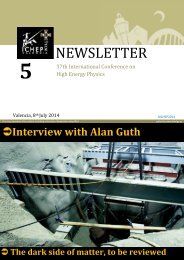PW_mar13_sample_issue
PW_mar13_sample_issue
PW_mar13_sample_issue
Create successful ePaper yourself
Turn your PDF publications into a flip-book with our unique Google optimized e-Paper software.
physicsworld.com<br />
atoms share the same wavefunction, and thus behave<br />
like a single “matter wave” – are first trapped in a 2D<br />
plane. The atoms are then transferred into an eggcarton-shaped<br />
lattice potential of light, which at the<br />
same time helps to bring the atoms into an interesting,<br />
strongly interacting quantum phase. Before the<br />
atoms are imaged, the depth of the lattices is suddenly<br />
increased to stop the atoms moving and hold<br />
them tight in space. Then, a laser beam with a frequency<br />
near resonance with an atomic transition is<br />
switched on, causing the atoms to fluoresce like tiny<br />
nanoscopic light bulbs. The resulting array of nanobulbs<br />
can be imaged using a high-resolution microscope<br />
objective (figure 1).<br />
The precise moment when the first photons of the<br />
imaging laser beam are scattered off the atoms is<br />
crucial for the quantum-measurement process. Initially,<br />
the atoms are in a complicated quantum superposition<br />
state of different spatial configurations, with<br />
a many-body wavefunction Ψ(x 1…x N). The measurement<br />
process collapses this wavefunction, and the<br />
atoms are observed to be in one of many possible<br />
spatial configurations. Image-processing algorithms<br />
allow us to reconstruct the position of each individual<br />
atom in the lattice, but the particular configuration<br />
of atoms observed in a single snapshot is, of<br />
course, completely random. Only by repeating the<br />
experiment many times does it become possible to<br />
build up a histogram of the occurrences of different<br />
spatial configurations. Examples of such reconstructed<br />
particle positions for two distinct phases of<br />
matter – a BEC and a Mott insulator – can be seen<br />
in figure 2.<br />
Mapping fluctuations<br />
Just being able to image single atoms in a lattice<br />
is pretty exciting in itself, but it gets better. If you<br />
take a close look at the reconstructed images in figure<br />
2 b–c, you will see some gaps, or defects, in the<br />
lattice. These “missing atoms” represent individual<br />
thermal fluctuations, and they are directly visible in<br />
a single shot of the experiment. Being able to see single<br />
thermal fluctuations in such a system gives us an<br />
extremely precise thermometer, which has allowed<br />
researchers to determine temperatures down to the<br />
100 pK level using just a single image.<br />
Perhaps more importantly, the “quantum gas<br />
microscope” also enables us to directly observe the<br />
zero-temperature quantum fluctuations of a manybody<br />
system. Many readers will have encountered<br />
such quantum fluctuations in the classic textbook<br />
example of a single quantum particle in the absolute<br />
ground state of a harmonic oscillator. In this simple<br />
system, the position of the particle remains undetermined<br />
within a region given by the extension of<br />
the ground state wavefunction – in sharp contrast<br />
with the behaviour of a classical particle at zero temperature,<br />
for which position and momentum would<br />
always be well defined.<br />
A quantum many-body system also exhibits such<br />
inherent quantum fluctuations, and when they<br />
become very strong, these fluctuations can give<br />
rise to a phase transition – specifically, to a quantum<br />
phase transition that occurs even at zero tem-<br />
1 Quantum gas microscope<br />
a<br />
high-resolution<br />
objective<br />
z<br />
Quantum frontiers: Quantum simulation<br />
y<br />
16 µm<br />
x<br />
(a) Ultracold atoms trapped in a single plane of an optical lattice are imaged using a highresolution<br />
microscope that detects the atoms’ laser-induced fluorescence. (b) A typical<br />
image of atoms trapped in the lattice.<br />
2 Imaging different phases of matter<br />
perature. Quantum gas microscopes thus offer us<br />
the chance to learn how the re-ordering of a system<br />
takes place during a phase transition, and on what<br />
timescales. This is an unparalleled glimpse into the<br />
inner workings and dynamics of many-body systems,<br />
and one that would simply not be possible in this<br />
detail for a real material.<br />
In addition to using the phenomenal spatial resolution<br />
of quantum gas microscopes to observe single<br />
atoms, one can also perform other experiments.<br />
Physics World March 2013 49<br />
b<br />
optical lattice<br />
laser beams<br />
a b c<br />
Atoms in a Bose–Einstein condensate (BEC) can be described by one macroscopic<br />
wavefunction, but at the same time a BEC in a lattice exhibits large fluctuations in the<br />
number of atoms per lattice site, n, thanks to an uncertainty-like relationship between n and<br />
the wavefunction phase Φ (Δn ΔΦ > 1). In contrast, if the atoms are in a different phase of<br />
matter, known as a Mott insulator, strong repulsive interactions between the atoms destroy<br />
the coherent matter-wave field of the BEC, but they also suppress fluctuations in particle<br />
number. The result is an almost perfect ordering of atoms in the lattice, with one atom<br />
occupying every lattice site.<br />
(a) Reconstructed atom positions in a BEC and (b–c) strongly interacting Mott<br />
insulators. The hole in c actually corresponds to a region where two atoms are occupying<br />
every central lattice site. This region appears dark because the presence of near-resonant<br />
laser light induces interactions between pairs of atoms trapped in the same lattice site,<br />
causing both atoms in the pair to escape the lattice. Hence, bright areas in the images<br />
correspond to odd-numbered lattice occupancies.<br />
Nature 467 68; reused with permission<br />
I Bloch, MPQ








